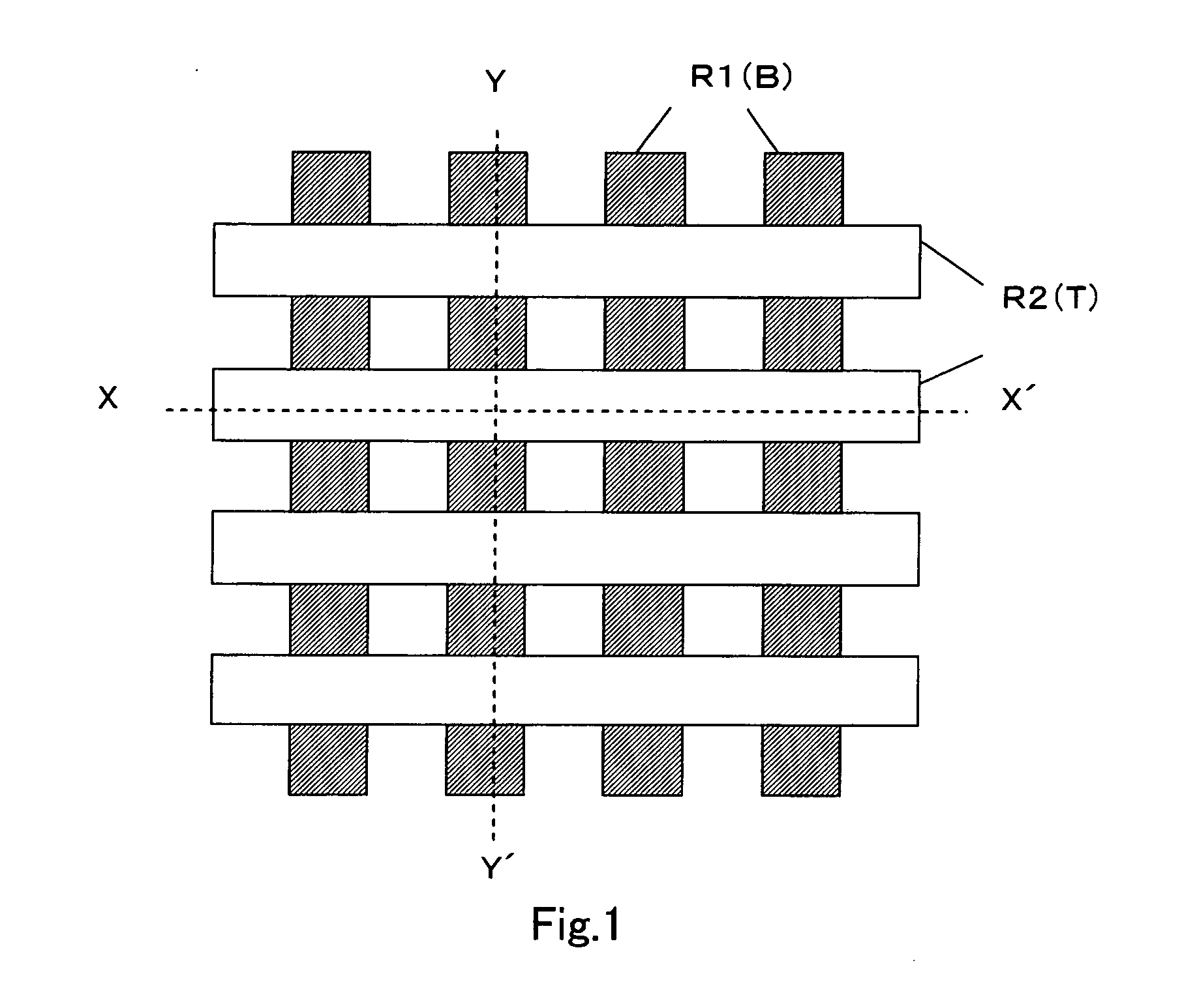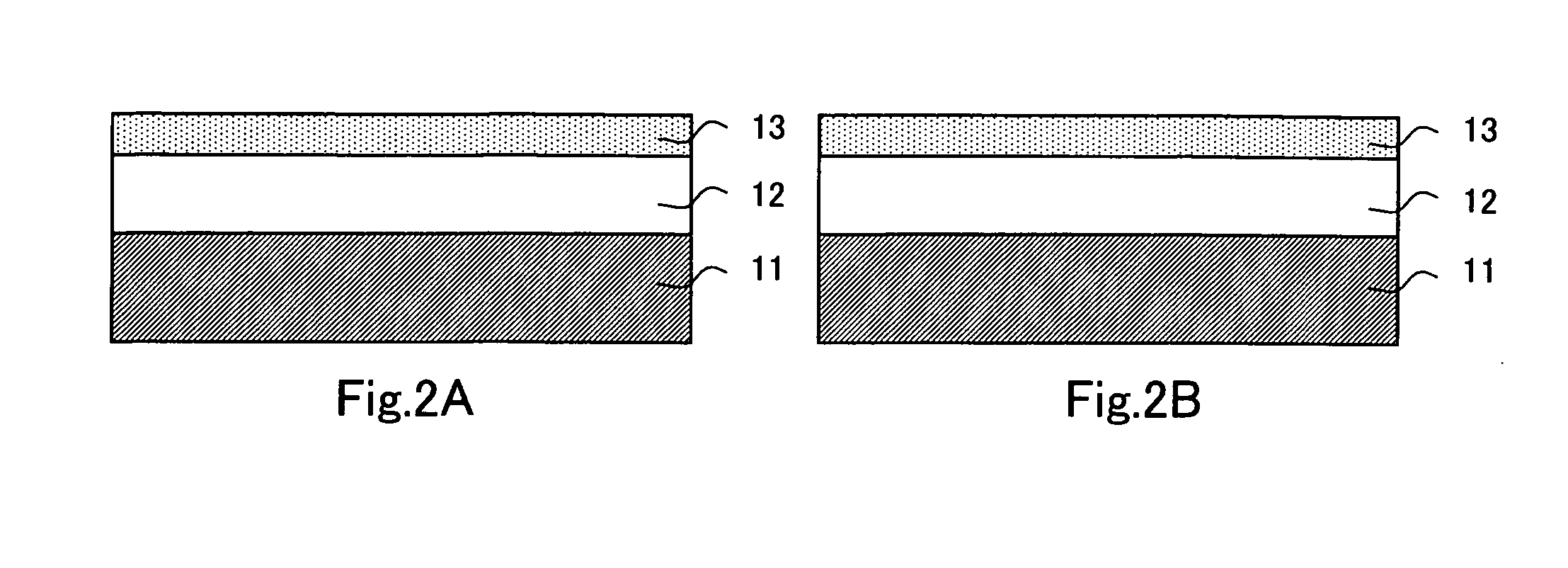Semiconductor memory device
a semiconductor and memory technology, applied in the direction of semiconductor devices, basic electric elements, electrical appliances, etc., can solve the problems of reducing the electrical characteristics of memory action, etching damage on the side walls of the resistor layer, and troublesome depositing the resistor layer over the stepped, so as to minimize the dependence on the width of the electrode line, the effect of reducing the resistance of unwanted variations and minimizing the resistan
- Summary
- Abstract
- Description
- Claims
- Application Information
AI Technical Summary
Benefits of technology
Problems solved by technology
Method used
Image
Examples
first embodiment
(First Embodiment)
[0060]FIGS. 2A to 7A and FIGS. 2B to 7B illustrate steps of the inventive method showing the first embodiment of the present invention. FIGS. 2A to 7A are vertical cross sectional views taken along the line X-X′ of FIG. 1. Similarly, FIGS. 2B to 7B are vertical cross sectional views taken along the line Y-Y═ of FIG. 1. The term “vertical” in this specification means a direction vertical to the surface of a semiconductor substrate 11 unless otherwise specified.
[0061] The procedure starts with, similar to the conventional method, depositing a BPSG layer 12 to a thickness of 1300 nm, which serves as the interlayer insulating layer under a memory cell, on the silicon semiconductor substrate 11 on which transistor circuits (not shown) are patterned and polishing the same to a thickness of 600 nm by a CMP (chemical mechanical polishing) technique to planarize its surface. Then as shown in FIGS. 2A and 2B, a sputtering step is conducted for depositing a Pt layer 13 (acti...
second embodiment
(Second Embodiment)
[0068] The second embodiment of the inventive method will now be described referring to the relevant drawings. The second embodiment is a modification of the first embodiment and particularly, its step of providing the lower electrode lines B is different from that of the first embodiment. FIGS. 8A to 12A and FIGS. 8B to 12B illustrate steps of the inventive method of the second embodiment. FIGS. 8A to 12A are vertical cross sectional views taken along the line X-X′ of FIG. 1. Similarly, FIGS. 8B to 12B are vertical cross sectional views taken along the line Y-Y′ of FIG. 1.
[0069] The procedure starts with, similar to the conventional method, depositing a BPSG layer 12 to a thickness of 1300 nm, which serves as the interlayer insulating layer under a memory cell, on the silicon semiconductor substrate 11 on which transistor circuits (not shown) are patterned and polishing the same to a thickness of 800 nm by a CMP (chemical mechanical polishing) technique to plana...
third embodiment
(Third Embodiment)
[0074] The third embodiment of the inventive method will then be described referring to the relevant drawings. The third embodiment is a modification of the first or second embodiment and particularly, its annealing step is different in both the order and the purpose from that of the first or second embodiment. FIGS. 13A and 14A and FIGS. 13B and 14B illustrate summary steps of the inventive method of the third embodiment. FIGS. 13A and 14A are vertical cross sectional views taken along the line X-X′ of FIG. 1. Similarly, FIGS. 13B and 14B are vertical cross sectional views taken along the line Y-Y of FIG. 1.
[0075] The procedure starts with the step of providing the lower electrode lines B similar to that of the first or second embodiment and then depositing a resistor (PCMO) layer 15 made of a PCMO material (Pr0.7Ca0.3MnO3) for developing a memory element over the semiconductor substrate provided with the lower electrode lines B or a combination of the lower elec...
PUM
 Login to View More
Login to View More Abstract
Description
Claims
Application Information
 Login to View More
Login to View More - R&D
- Intellectual Property
- Life Sciences
- Materials
- Tech Scout
- Unparalleled Data Quality
- Higher Quality Content
- 60% Fewer Hallucinations
Browse by: Latest US Patents, China's latest patents, Technical Efficacy Thesaurus, Application Domain, Technology Topic, Popular Technical Reports.
© 2025 PatSnap. All rights reserved.Legal|Privacy policy|Modern Slavery Act Transparency Statement|Sitemap|About US| Contact US: help@patsnap.com



